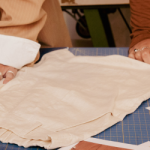In the captivating realm of fashion, designers serve as architects of style, weaving creativity into fabric. A fashion designer’s role transcends mere clothing creation; it’s about crafting a narrative through attire. This blog unravels the intricacies of their world—who is a fashion designer, the fashion designer qualifications, and the skills essential for mastering the art of fashion design.
In this blog, we will delve into the essence of fashion design—what it truly means, the role of fashion designer, the academic qualifications necessary to embark on this creative journey, and the courses that pave the way. Additionally, we’ll unravel the skills imperative for mastering the dynamic and ever-evolving field of fashion designing.
Table of content
What does a Fashion Designer do
Academic Qualifications for a Career in Fashion Design
Courses to Become a Fashion Designer
Skills Required to Master Fashion Designing
Types of Fashion Designers
How Much Time Does It Take to Become a Fashion Designer
What does a Fashion Designer do?
Once the fashion designer qualification is done and they start their career, a fashion designer assumes diverse roles and responsibilities throughout the intricate process of bringing designs to life. This multifaceted profession involves:
Roles and Responsibilities of Fashion Designer
- Research and Conceptualization – Conducting thorough research on trends, demographics, and cultural influences to conceptualize innovative and market-relevant designs.
- Sketching and Design Development – Translating concepts into detailed sketches and designs, utilizing both traditional methods and digital tools for precision.
- Fabric Selection and Sourcing – Meticulously choosing fabrics and collaborating with suppliers to source materials that align with design concepts.
- Pattern Making and Prototyping – Creating intricate patterns for garment construction and overseeing the development of prototypes for design testing.
- Collaboration and Team Management – Collaborating with a team of professionals, including pattern-makers and manufacturers, while effectively managing projects and timelines.
- Fashion Shows and Presentations – Curating captivating presentations for fashion shows, highlighting the artistic narrative behind each collection.
- Market Analysis and Trend Forecasting – Analyzing market trends, consumer behaviors, and forecasting future styles to inform design decisions.
- Business and Branding – Engaging in business aspects, including brand development, marketing strategies, and maintaining a consistent brand identity.
- Adaptation and Innovation – Staying agile in the face of evolving trends, technologies, and consumer preferences, fostering innovation in design.
- Quality Control – Overseeing the entire production process and conducting stringent quality checks to ensure the integrity of the final products.
Fashion designers navigate this dynamic landscape with a blend of artistic flair, technical proficiency, and strategic thinking, contributing significantly to the ever-evolving world of fashion.
Academic Qualifications for a Career in Fashion Design
Embarking on a career in fashion design typically requires a blend of formal education and practical training. Here are the common fashion designer qualifications for a career in fashion designing:
- Degree in Fashion Design – A foundational step, a degree in fashion design provides comprehensive education in design principles, garment construction, textiles, and pattern-making.
- Associate Degree in Fashion Design – An associate degree offers a more condensed curriculum, providing fundamental knowledge in design and sewing. It can be a stepping stone or a standalone qualification.
- Diploma or Certificate Programs – Short-term diploma or certificate programs focus on specific aspects of fashion design, offering targeted training in areas like pattern drafting or fashion illustration.
- Fashion Design Courses – Enrolling in specific courses related to fashion design, either online or at specialized institutions, allows individuals to acquire skills in areas such as CAD (Computer-Aided Design) or draping.
- Internships and Apprenticeships – While not traditional academic qualifications, hands-on experience gained through internships or apprenticeships is highly valued. It provides practical insights into the industry.
- Continuing Education – Fashion is a dynamic field, and designers often engage in continuing education to stay updated on emerging trends, technologies, and techniques.
- Portfolio Development – Regardless of formal education, a strong portfolio showcasing a range of design projects is crucial. Portfolios demonstrate creativity, technical skills, and the ability to bring concepts to life.
- Specialized Courses in Fashion Specializations – Depending on career goals, individuals may pursue specialized courses in areas such as bridal wear, sustainable fashion, or accessory design.
It’s important to note that while academic fashion designer qualifications provide foundation, creativity, a keen sense of style, and practical skills are equally vital for success in the competitive field of fashion design. Aspiring designers often complement formal education with internships, personal projects, and networking to enhance their prospects in the industry.
Courses to Become a Fashion Designer
Here’s a list of courses to become a fashion designer:
- AAFT Online – Diploma in Fashion Design: This comprehensive online program equips aspiring designers with the skills needed for success in the dynamic world of fashion. Covering design principles, garment construction, and industry insights, it provides a solid foundation.
- Bachelor’s Degree in Fashion Design: Pursuing a full-time bachelor’s degree in fashion design offers an in-depth curriculum covering design theory, pattern-making, textiles, and fashion illustration.
- Associate Degree in Fashion Design: An associate degree provides a condensed yet comprehensive education in fashion design, suitable for those seeking a more streamlined approach to the field.
- Short-Term Courses in CAD for Fashion Design: Specialized courses in Computer-Aided Design (CAD) for fashion offer valuable skills in using technology for design, an increasingly essential aspect of the industry.
- Certificate Programs in Pattern Making: Certificates in pattern making focus on the technical aspect of translating design sketches into tangible garments, a critical skill for fashion designers.
- Online Courses in Sustainable Fashion: With sustainability becoming a key focus in the industry, online courses in sustainable fashion provide insights into eco-friendly practices and ethical design.
- Specialization Courses in Accessories Design: For those interested in accessory design, specialized courses in this field cover the unique challenges and techniques associated with creating fashion accessories.
- Short-Term Workshops on Fashion Illustration: Workshops focused on fashion illustration enhance the ability to visually communicate design ideas, an essential skill for any fashion designer.
Remember, the choice of course depends on individual preferences, career goals, and the specific areas within fashion design one wishes to specialize in. Combining formal education with practical experience through internships and personal projects is often key to a successful career in fashion design.
Skills Required to Master Fashion Designing
Mastering the art of fashion designing demands a diverse set of skills, blending creativity with technical prowess and business acumen. Here are the key skills essential for success in the field:
- Creativity – The ability to generate unique and imaginative design concepts is the cornerstone of fashion designing. Creative thinking helps designers stand out in a competitive industry.
- Drawing and Illustration – Proficient drawing and illustration skills enable designers to communicate their ideas visually. Fashion illustration is crucial for conveying design details and concepts.
- Technical Proficiency – Mastering technical aspects, including pattern-making, sewing, and garment construction, is fundamental. A strong foundation in these skills ensures designs are not only creative but also technically sound.
- Knowledge of Fabrics and Textiles – Understanding the properties of different fabrics and textiles is vital. Designers must know how materials behave to make informed choices in creating garments.
- Attention to Detail – Meticulous attention to detail ensures precision in every aspect of design, from the choice of buttons to the stitching technique. It contributes to the overall quality of the finished product.
- Fashion Trends Awareness – Staying abreast of current fashion trends and having an awareness of historical styles helps designers create relevant and marketable designs.
- Color Theory – A solid grasp of color theory is crucial for creating harmonious and visually appealing designs. Designers need to understand how colors interact and evoke different emotions.
- Communication Skills – Effective communication is essential when collaborating with teams, presenting design ideas, or working with clients. Clear communication ensures everyone involved understands the design vision.
- Business Acumen – A basic understanding of the business side of fashion, including market trends, consumer behavior, and budgeting, is vital for success, especially for designers aiming to establish their brands.
- Adaptability – The fashion industry is dynamic and ever-changing. Designers need to adapt to evolving trends, technologies, and consumer preferences to stay relevant.
- Time Management – Meeting deadlines is crucial in the fast-paced world of fashion. Effective time management ensures that designs are completed on schedule, especially in preparation for fashion shows or collection launches.
- Networking Skills – Building professional connections within the fashion industry is essential for exposure and opportunities. Networking helps designers stay informed about industry trends and collaborate with other professionals.
Mastering these skills not only enhances a fashion designer’s ability to create compelling designs but also contributes to long-term success in the competitive and dynamic fashion landscape.
Types of Fashion Designers
Here’s a closer look at these types:
- Haute Couture: High-end, made-to-order fashion created for individual clients with the highest level of craftsmanship. It’s often custom-made and exclusive, showcasing the pinnacle of design and luxury.
- Luxury Fashion: This includes high-quality, prestigious brands known for their exceptional craftsmanship, quality materials, and exclusivity. These brands often set trends and maintain a high price point.
- Ready-to-wear Fashion: Also known as “prêt-à-porter,” this refers to mass-produced clothing available in standard sizes and readily accessible in stores. It’s more affordable and designed for the general public.
- Economy Fashion: This category encompasses affordable, budget-friendly clothing designed for everyday wear. It’s characterized by its accessibility, simplicity, and often reflects current trends.
- Fast Fashion: This sector focuses on quickly producing affordable clothing to mimic the latest trends seen on runways or in luxury fashion. It’s known for its rapid turnover of styles and lower prices.
Each type caters to different consumer needs, preferences, and price ranges, contributing to the diverse landscape of the fashion industry.
How Much Time Does It Take to Become a Fashion Designer?
Becoming a fashion designer typically involves a combination of formal education, practical experience, and continuous skill development. Short-term diploma or certificate programs may take around 6 months to 1 year, while an associate degree usually requires 2 years of full-time study. A bachelor’s degree in fashion design typically takes 3 to 4 years. However, gaining practical experience through internships and entry-level positions is an ongoing process throughout one’s education and can continue post-graduation. Additionally, fashion designers often engage in continuing education to stay current in the industry, making the journey dynamic and continuously evolving. The specific time to become a fashion designer can vary based on individual circumstances and career aspirations.
Conclusion
In conclusion, reflecting on the journey, it becomes evident who is a fashion designer and the qualifications they hold. This dynamic process intertwines education, experience, and skill development. Fashion designers, equipped with varied fashion designer qualifications, play a pivotal role in shaping the industry’s aesthetics. As creative visionaries, they bring unique concepts to life, navigating the intersection of art, culture, and commerce. Their blend of technical expertise and artistic flair defines the ever-evolving fashion landscape, making them integral contributors to style and self-expression.


















